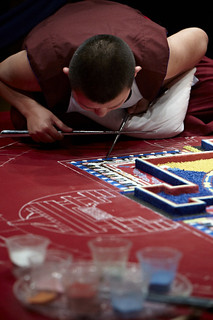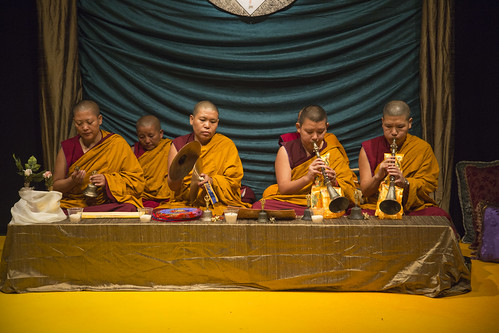Tibetan nuns create a sand mandala at Trinity
by Rhea Hirshman

Photo by Bob Handelman
On a cloudy, mild Saturday afternoon in mid-October, anyone walking near the Charter Oak landing at the Connecticut River would have seen the unusual sight of a contingent of six Tibetan Buddhist nuns in full ritual regalia. In the company of students, faculty, staff, and friends of Trinity, as well as a group of Tibetans from New York City, the nuns were performing the final part of an ancient ritual. Having spent the better part of their six-week stay at Trinity creating a mandala, a sacred sand construction representing the palace of the Buddhist deity of compassion, the nuns had ceremoniously dismantled it that morning and were now pouring the brightly-colored sand into the river—taking the spiritual power of the mandala and offering it back to the earth.
Long-standing Trinity connection
The connection between Trinity and the nuns, whose home is the Keydong Thuk-Che-Cho-Ling Nunnery in Kathmandu, Nepal, dates back to 1998, when Trinity faculty members Judy Dworin and Ellison Findly, and alumna Melissa Kerin ’94, collaborated to bring a group of the nuns to campus. Kerin’s involvement with the nunnery began when she lived there during her junior year, participating in the nuns’ daily lives and immersing herself in Buddhist practice. A fellowship took her back there after graduation and, in 1996, she returned to Trinity to present a paper on her experiences at a conference called Revoicing the Feminine Sacred, organized by Dworin, a professor of theater and dance, and Findly, a professor of religion and international studies who herself engages in Buddhist practice. At that conference, Dworin recalls, “A woman in the audience, in response to Melissa’s presentation, suggested, ‘Why don’t we bring the nuns here,’ and we decided to give it a try.”
Two years later, Kerin was again traveling to Nepal, this time to accompany the Keydong nuns on their first trip to Trinity, where they became the first Buddhist nuns to create a sand mandala in the United States. Their presence sparked numerous mandala-inspired activities, including a performance piece called Wheel, choreographed by Dworin, and connections with a local elementary school, whose students developed a performance piece of their own.
After their time at Trinity, the nuns were invited to Brandeis University, where his holiness Tenzin Gyatso, the 14th Dalai Lama of Tibet, was receiving an honorary degree, and where the nuns created another mandala. “For the first time,” Findly says, “the Dalai Lama, who had given his blessing to the nuns’ endeavors, oversaw the dismantling of a mandala that had been created by women.”
Dworin remained in close contact with Ani Ngawang Tendol, who serves as the group’s leader and interpreter. (“Ani” is the honorific prefix used before a nun’s name in Tibetan Buddhism.) Nuns from Keydong returned to Trinity to create another mandala during a shorter stay in 2005. Then, last year, Dworin and co-organizer James Latzel, noting that seven years had passed, thought that this would be a good time to have the nuns here again.
The nuns’ story

Photo by John Marinelli
The Keydong nuns’ own long journey to a safe home began in 1959, when China occupied Tibet, the Dalai Lama fl ed, and many Tibetans sought refuge in Nepal and India. Among the refugees was a small group of women monastics from Tibet’s southwestern Keydong region. The nuns first settled in a Nepalese border village, moving to Kathmandu in 1980 and then traveling throughout Nepal and India seeking donations to purchase land and a small house.
The nunnery has grown, becoming a center of education and spiritual practice for approximately 130 nuns from India, Nepal, and Tibet. Kerin notes that the Keydong nuns are “part of a sea change—but a gradual one—in Buddhist monasticism.” While the primary focus of Tibetan Buddhist nunneries has traditionally been performing prayer ceremonies for the world and cultivating contemplative practices, the Keydong nunnery is one of the first to develop an educational program that includes Tibetan debate, Tibetan language, Tibetan ritual arts, English, mathematics, health, and traditional Tibetan medicine. The nuns sometimes tend the sick and may also do community organizing, advocating for better conditions and services for people in their neighborhood.
In addition, the Keydong nuns have been pursuing higher Tibetan religious education, including learning sand mandala creation, a practice involving scriptural knowledge, meditation, and the development of specific techniques. Reserved for centuries to highly-educated male monastics, mandala creation, says Kerin, an assistant professor of art history at Washington and Lee University, “is one of the most meritorious activities that one can undertake in the Tibetan Buddhist world,” and one available now to women in large part because of the support of the Dalai Lama. “In the past,” she adds, “nuns were not oriented toward studying the scriptures, but more toward devotional practice . . . . But the scriptures never actually stated that nuns were not allowed to make sand mandalas.”
Mandala as meditation
Each mandala is an act of meditation at the same time that it is an extraordinary work of art, a celestial palace with complex and beautiful architecture supporting a wealth of symbols. “If the mandala is done correctly,” Kerin says, “the deity takes up residence along with its entire retinue. Creating the mandala means creating opportunity for sentient beings to experience the divine presence.”

Garmany Hall,where the nuns worked, was open to the Trinity community and the public six days each week. While the nuns were in residence, the campus hosted related activities, including a keynote address by Kerin entitled “Tradition Changing Women, Women Changing Tradition: The Interface of Tibetan Nuns and the Sacred Art of Sand Mandala Making.” Trinity classes visited, as well as students from throughout the region, community groups, and thousands of individuals.
“The impact of the mandala on the campus was palpable,” Dworin says. “The work of creating the mandala is an example of sacred ritual that becomes unintended performance by the fact that people witness it.” As Alanna Lynch ’14, one of Dworin’s students, wrote: “This idea, the interconnectivity of the particles that make up the universe, is part of the reason the mandala is so moving for me. It is the representation of the beauty of bringing those particles together. To create something so beautiful from dust, from nothing, fills me with a sense of wonder.”
Inherent in the creation of the mandala and essential to its message is the knowledge of its own inevitable transformation, done with the same attention to ritual detail. Findly describes the process as “de-sacralizing”: removing the sand in a specific way, cutting through the mandala in each of the four primary directions and the midpoints, and sweeping the sand into jars and chanting and circumambulating the site of the mandala. “The main jar is wrapped in brocade,” she explains, “much as a dead body would be in Tibetan Buddhist tradition.” Then it’s on to the nearest river where the sand’s bright colors, now transmogrifi ed into a neutral gray, become part of the water’s flow.
“Buddhism teaches us that the world is transitory, and we suffer when we are attached to transitory things” Findly says. “We become attached to the process and the beauty of the mandala itself, and are sad when we see this beautiful creation being undone. What the mandala tells us is that we can care and have compassion, but cannot possess and cling to.”
Dworin adds, “There is also something beautiful about the final ritual, reminding us of the cyclical nature of life. The mandala is gone — but who knows where the energy of that sand may turn up again?”
Watch “The Sacred Art of Sand at Trinity College”
